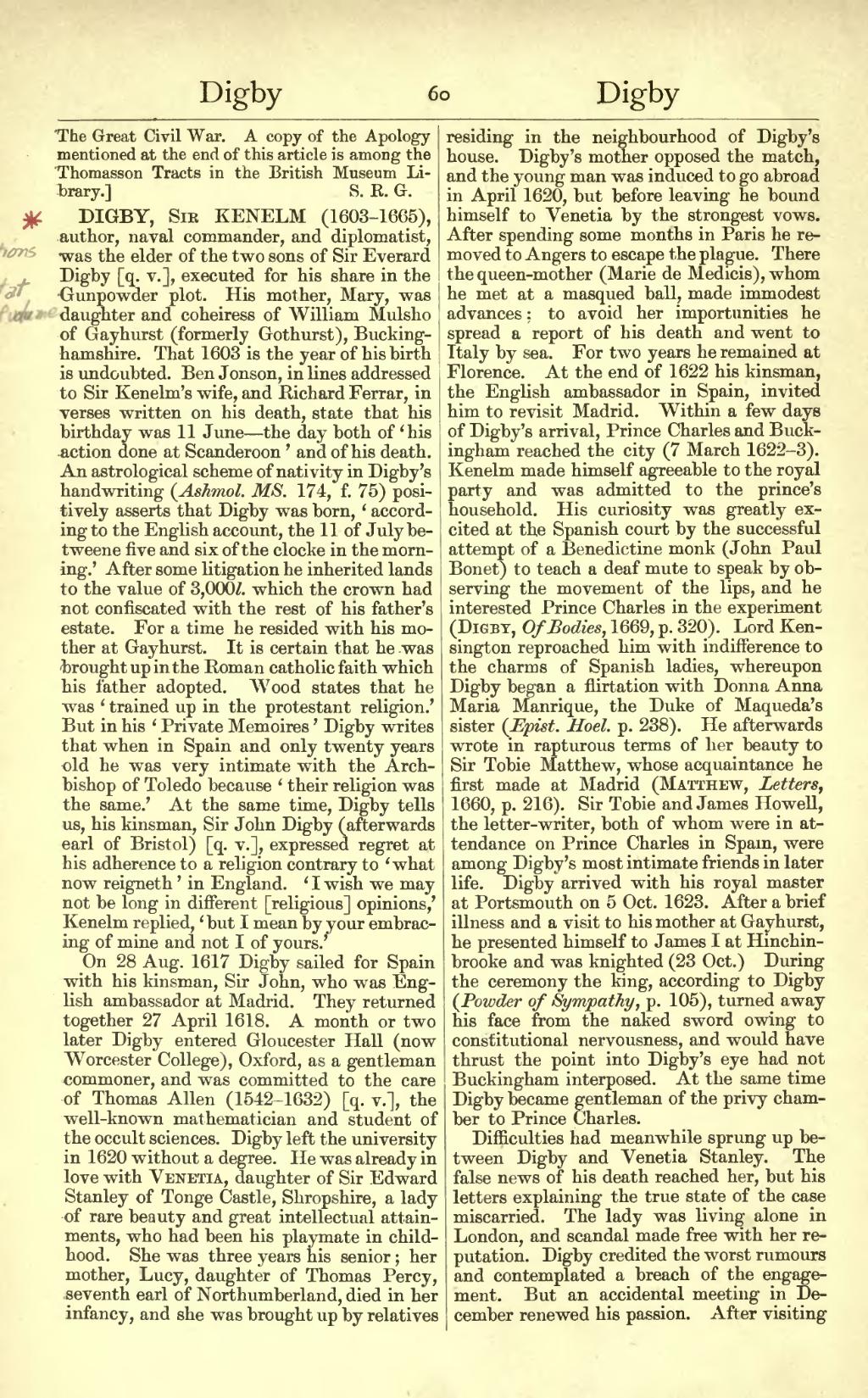DIGBY, Sir KENELM (1603–1665), author, naval commander, and diplomatist, was the elder of the two sons of Sir Everard Digby [q. v.], executed for his share in the Gunpowder plot. His mother, Mary, was daughter and coheiress of William Mulsho of Gayhurst (formerly Gothurst), Buckinghamshire. That 1603 is the year of his birth is undoubted. Ben Jonson, in lines addressed to Sir Kenelm's wife, and Richard Ferrar, in verses written on his death, state that his birthday was 11 June—the day both of ‘his action done at Scanderoon’ and of his death. An astrological scheme of nativity in Digby's handwriting (Ashmol. MS. 174, f. 75) positively asserts that Digby was born, ‘according to the English account, the 11 of July betweene five and six of the clocke in the morning.’ After some litigation he inherited lands to the value of 3,000l. which the crown had not confiscated with the rest of his father's estate. For a time he resided with his mother at Gayhurst. It is certain that he was brought up in the Roman catholic faith which his father adopted. Wood states that he was ‘trained up in the protestant religion.’ But in his ‘Private Memoires’ Digby writes that when in Spain and only twenty years old he was very intimate with the Archbishop of Toledo because ‘their religion was the same.’ At the same time, Digby tells us, his kinsman, Sir John Digby (afterwards earl of Bristol) [q. v.], expressed regret at his adherence to a religion contrary to ‘what now reigneth’ in England. ‘I wish we may not be long in different [religious] opinions,’ Kenelm replied, ‘but I mean by your embracing of mine and not I of yours.’
On 28 Aug. 1617 Digby sailed for Spain with his kinsman, Sir John, who was English ambassador at Madrid. They returned together 27 April 1618. A month or two later Digby entered Gloucester Hall (now Worcester College), Oxford, as a gentleman commoner, and was committed to the care of Thomas Allen (1542–1632) [q. v.], the well-known mathematician and student of the occult sciences. Digby left the university in 1620 without a degree. He was already in love with Venetia, daughter of Sir Edward Stanley of Tonge Castle, Shropshire, a lady of rare beauty and great intellectual attainments, who had been his playmate in childhood. She was three years his senior; her mother, Lucy, daughter of Thomas Percy, seventh earl of Northumberland, died in her infancy, and she was brought up by relatives residing in the neighbourhood of Digby's house. Digby's mother opposed the match, and the young man was induced to go abroad in April 1620, but before leaving he bound himself to Venetia by the strongest vows. After spending some months in Paris he removed to Angers to escape the plague. There the queen-mother (Marie de Medicis), whom he met at a masqued ball, made immodest advances; to avoid her importunities he spread a report of his death and went to Italy by sea. For two years he remained at Florence. At the end of 1622 his kinsman, the English ambassador in Spain, invited him to revisit Madrid. Within a few days of Digby's arrival, Prince Charles and Buckingham reached the city (7 March 1622–3). Kenelm made himself agreeable to the royal party and was admitted to the prince's household. His curiosity was greatly excited at the Spanish court by the successful attempt of a Benedictine monk (John Paul Bonet) to teach a deaf mute to speak by observing the movement of the lips, and he interested Prince Charles in the experiment (Digby, Of Bodies, 1669, p. 320). Lord Kensington reproached him with indifference to the charms of Spanish ladies, whereupon Digby began a flirtation with Donna Anna Maria Manrique, the Duke of Maqueda's sister (Epist. Hoel. p. 238). He afterwards wrote in rapturous terms of her beauty to Sir Tobie Matthew, whose acquaintance he first made at Madrid (Matthew, Letters, 1660, p. 216). Sir Tobie and James Howell, the letter-writer, both of whom were in attendance on Prince Charles in Spain, were among Digby's most intimate friends in later life. Digby arrived with his royal master at Portsmouth on 5 Oct. 1623. After a brief illness and a visit to his mother at Gayhurst, he presented himself to James I at Hinchinbrooke and was knighted (23 Oct.) During the ceremony the king, according to Digby (Powder of Sympathy, p. 105), turned away his face from the naked sword owing to constitutional nervousness, and would have thrust the point into Digby's eye had not Buckingham interposed. At the same time Digby became gentleman of the privy chamber to Prince Charles.
Difficulties had meanwhile sprung up between Digby and Venetia Stanley. The false news of his death reached her, but his letters explaining the true state of the case miscarried. The lady was living alone in London, and scandal made free with her reputation. Digby credited the worst rumours and contemplated a breach of the engagement. But an accidental meeting in December renewed his passion. After visiting
